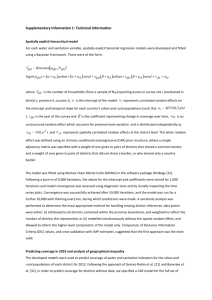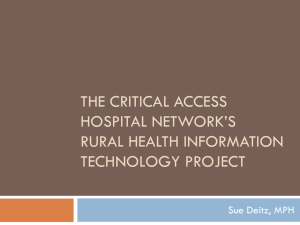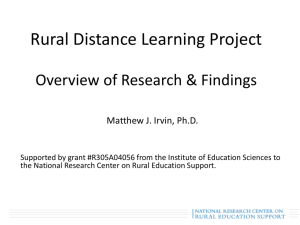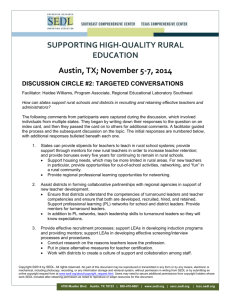Support for Reform (handout)
advertisement
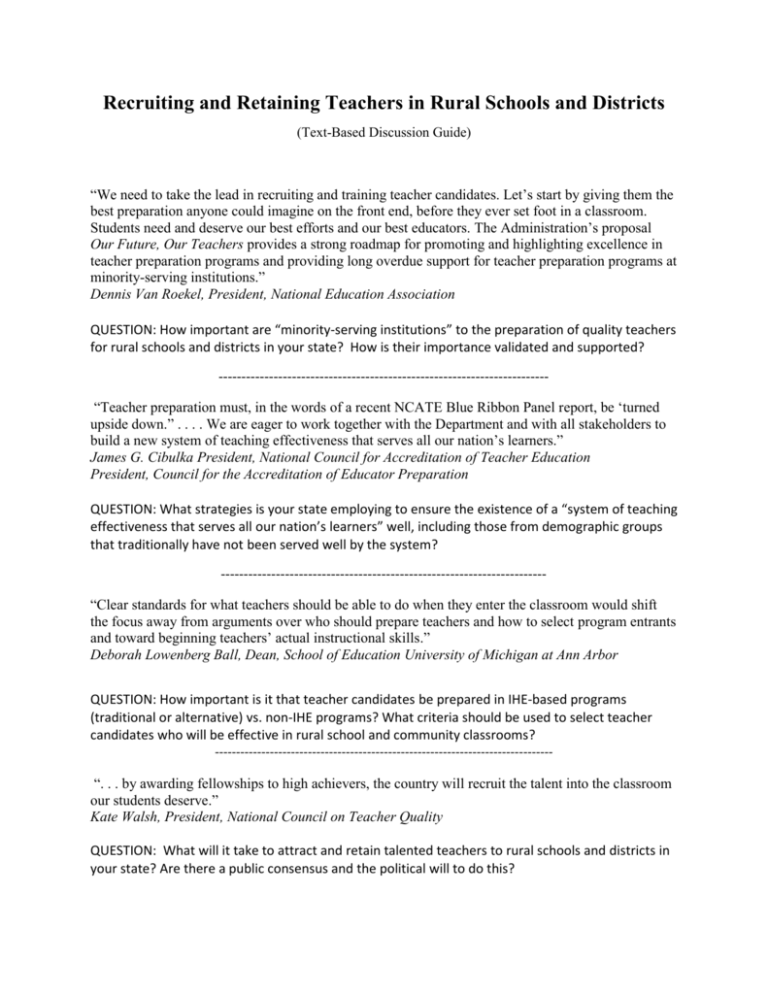
Recruiting and Retaining Teachers in Rural Schools and Districts (Text-Based Discussion Guide) “We need to take the lead in recruiting and training teacher candidates. Let’s start by giving them the best preparation anyone could imagine on the front end, before they ever set foot in a classroom. Students need and deserve our best efforts and our best educators. The Administration’s proposal Our Future, Our Teachers provides a strong roadmap for promoting and highlighting excellence in teacher preparation programs and providing long overdue support for teacher preparation programs at minority-serving institutions.” Dennis Van Roekel, President, National Education Association QUESTION: How important are “minority-serving institutions” to the preparation of quality teachers for rural schools and districts in your state? How is their importance validated and supported? ------------------------------------------------------------------------ “Teacher preparation must, in the words of a recent NCATE Blue Ribbon Panel report, be ‘turned upside down.” . . . . We are eager to work together with the Department and with all stakeholders to build a new system of teaching effectiveness that serves all our nation’s learners.” James G. Cibulka President, National Council for Accreditation of Teacher Education President, Council for the Accreditation of Educator Preparation QUESTION: What strategies is your state employing to ensure the existence of a “system of teaching effectiveness that serves all our nation’s learners” well, including those from demographic groups that traditionally have not been served well by the system? ----------------------------------------------------------------------- “Clear standards for what teachers should be able to do when they enter the classroom would shift the focus away from arguments over who should prepare teachers and how to select program entrants and toward beginning teachers’ actual instructional skills.” Deborah Lowenberg Ball, Dean, School of Education University of Michigan at Ann Arbor QUESTION: How important is it that teacher candidates be prepared in IHE-based programs (traditional or alternative) vs. non-IHE programs? What criteria should be used to select teacher candidates who will be effective in rural school and community classrooms? -------------------------------------------------------------------------------“. . . by awarding fellowships to high achievers, the country will recruit the talent into the classroom our students deserve.” Kate Walsh, President, National Council on Teacher Quality QUESTION: What will it take to attract and retain talented teachers to rural schools and districts in your state? Are there a public consensus and the political will to do this? ---------------------------------------------------------------- “Only 23% of all teachers, and only 14% of teachers in high-poverty schools, come from the top third of college graduates.” Auguste, B, Kihn, P., & Miller, M. (2010). Closing the talent gap: Attracting and retaining top-third graduates to careers in teaching. Washington, DC: McKinsey & Company. QUESTION: How important is it to attract and retain “top-third” graduates to teaching? What will it take to do this in your state? Will this ensure teacher effectiveness in rural schools and districts in your state? -------------------------------------------------------------------------------------------------------------------- “Only 50 percent of current teacher candidates receive supervised clinical training. More than three in five education school alumni report that their education school did not prepare them for ‘classroom realities’.” Levine, A. (2006). Educating school teachers. Washington, D.C.: The Education Schools Project. Retrieved from http://www. edschools.org/teacher_report.htm QUALITY: What are the current “classroom realities” for which teachers need to be prepared? What is necessary in teacher preparation to ensure that new teachers are prepared for those realities? _____________________________________________ “Research indicates that disadvantaged students benefit academically and socially from having teachers with whom they can identify. But such teachers are underrepresented in the workforce: 14 percent of teachers identify as African-American or Hispanic, compared to 38 percent of students. Only 2 percent of teachers are African-American men and only 2 percent are Latino men.” Duncan, A. (2010, November). Remarks by the U.S. Secretary of Education to the National Council for Accreditation of Teacher Education. QUESTION: How important is it to student success in rural schools and communities in your state that students have teachers with whom they can identify? What challenges do you face in this regard? What efforts are underway? -------------------------------------------------------------------------In a 2007 study, the National Commission on Teaching and America’s Future (NCTAF) concluded that the national cost of teacher attrition is over $7.3 billion. The Department of Labor estimates that attrition costs the employer 30% of the exiting employee’s salary. QUESTION: What does it cost to replace a teacher in your state? Except where indicated, quotes are taken from the following source: U.S. Department of Education. (2011). Our future, our teachers: The Obama administration’s plan for teacher education reform and improvement. Retrieved from http://www.ed.gov/teaching/our-future-our-teachers


